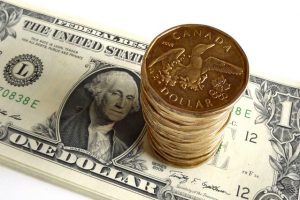 Yesterday’s trade saw USD/CAD within the range of 1.2912-1.3035. The pair closed at 1.2976, going down 0.35% on a daily basis. It has been the 51st drop in the past 103 trading days and also a third consecutive one. The daily low has been the lowest level since May 18th, when a low of 1.2890 was registered. The major pair has increased its advance to 3.69% so far during the current month, following three consecutive months of decline.
Yesterday’s trade saw USD/CAD within the range of 1.2912-1.3035. The pair closed at 1.2976, going down 0.35% on a daily basis. It has been the 51st drop in the past 103 trading days and also a third consecutive one. The daily low has been the lowest level since May 18th, when a low of 1.2890 was registered. The major pair has increased its advance to 3.69% so far during the current month, following three consecutive months of decline.
At 7:28 GMT today USD/CAD was edging up 0.40% on the day to trade at 1.3030. The pair touched a daily high at 1.3023 at 7:16 GMT and a daily low at 1.2969 during the early phase of the Asian session.
Canadas dollar continued to extend gains against its US counterpart, as crude oil futures tested highs unseen since October 2015 on Thursday before closing lower from a day ago. May 26th marked the 51st drop in crude oil prices out of the past 114 trading days. Oil for July delivery went up as high as $50.21 per barrel on May 26th, or the highest price level since October 9th, and closed at $49.38, shedding 0.36% compared to Wednesday’s close. As of 7:37 GMT today the commodity was edging down 0.43% to trade at $49.17, after going down as low as $49.02 per barrel earlier.
On Thursday USD/CAD trading may be influenced by the following macroeconomic reports and other events as listed below.
Fundamentals
United States
Gross Domestic Product – second estimate
The second estimate of the US Gross Domestic Product probably pointed to an annualized rate of growth of 0.9% in the first quarter of 2016, according to the median forecast by analysts. The preliminary GDP estimate for Q1, reported on April 28th, pointed to an annual growth of 0.5%, or the slowest since Q1 2014. In Q4 the US economy expanded at an annualized rate of 1.4%, according to final data. The preliminary report showed that Q1 growth was influenced by a slower increase in consumer spending, while business investment shrank for a third consecutive quarterly period. In addition, business inventories and international trade continued to have an adverse effect on growth.
According to provisional data, real personal consumption expenditures rose 1.9% during the first quarter, following an increase by 2.4% in Q4, which added 1.27 percentage points to growth. Fixed investment shrank 1.6% in Q1, following a 0.4% increase in the prior quarter. Non-residential investment contracted at a preliminary 5.9% in Q1, while residential investment went up 14.8% during the period. Fixed investment subtracted 0.27 percentage points from US growth.
On the other hand, private inventories subtracted 0.33 percentage points from economic growth in Q1.
Government expenditures contributed to 0.2 percentage points to growth during the same period, according to preliminary data by the US Bureau of Economic Analysis.
US exports contracted 2.6% in Q1, following a 2.0% slump in Q4. At the same time, the nations imports went up 0.2% in Q1, rebounding after a 0.7% drop in the fourth quarter, which resulted in a negative impact on GDP growth during the period (subtracting 0.34 percentage points).
In case the growth rate revision up was steeper than projected in Q1, this would have a strong bullish effect on the US dollar. The second GDP estimate is to be released at 12:30 GMT.
Reuters/Michigan Consumer Sentiment Index – final reading
The monthly survey by Thomson Reuters and the University of Michigan may show that consumer confidence in the United States improved in May from a month ago. The final reading of the corresponding index, which usually comes out two weeks after the preliminary data, probably came in at 95.4, down from a preliminary value of 95.8. If market expectations were met, this would be the highest level since June 2015, when the gauge of sentiment was reported at a final 96.1. In April the index stood at a final reading of 89.0, down from a preliminary value of 89.7. The survey encompasses about 500 respondents throughout the country. The index is comprised by two major components, a gauge of current conditions and a gauge of expectations. The current conditions index is based on the answers to two standard questions, while the index of expectations is based on three standard questions. All five questions have an equal weight in determining the value of the overall index.
According to preliminary data, the sub-index of current economic conditions, which measures US consumers’ views of their personal finances, went up to 108.6 in May from a final reading of 106.7 in April. The sub-index of consumer expectations accelerated to a flash reading of 87.5 in May from a final value of 77.6 in April.
Respondents in the May survey expect that the rate of inflation during the next year will probably be at 2.5%, or decelerating from 2.8% as expected in the April survey.
In case the final value of the May consumer sentiment index outpaced the median forecast by analysts, this would have a moderate bullish effect on the US dollar. The final reading is due out at 14:00 GMT.
Feds Yellen speech
At 14:30 GMT Federal Reserve Chair, Janet Yellen, is expected to take a statement. Her remarks will be closely watched for clues regarding the Banks policy decision next month.
Daily and Weekly Pivot Levels
By employing the Camarilla calculation method, the daily pivot levels for USD/CAD are presented as follows:
R1 – 1.2987
R2 – 1.2999
R3 (range resistance) – 1.3010
R4 (range breakout) – 1.3044
S1 – 1.2965
S2 – 1.2953
S3 (range support) – 1.2942
S4 (range breakout) – 1.2908
By using the traditional method of calculation, the weekly pivot levels for USD/CAD are presented as follows:
Central Pivot Point – 1.3037
R1 – 1.3239
R2 – 1.3366
R3 – 1.3568
S1 – 1.2910
S2 – 1.2708
S3 – 1.2581





